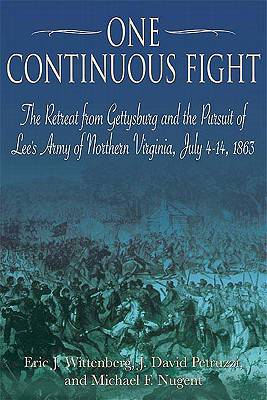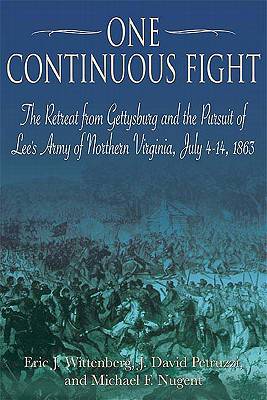
Je cadeautjes zeker op tijd in huis hebben voor de feestdagen? Kom langs in onze winkels en vind het perfecte geschenk!
- Afhalen na 1 uur in een winkel met voorraad
- Gratis thuislevering in België vanaf € 30
- Ruim aanbod met 7 miljoen producten
Je cadeautjes zeker op tijd in huis hebben voor de feestdagen? Kom langs in onze winkels en vind het perfecte geschenk!
- Afhalen na 1 uur in een winkel met voorraad
- Gratis thuislevering in België vanaf € 30
- Ruim aanbod met 7 miljoen producten
Zoeken
One Continuous Fight
The Retreat from Gettysburg and the Pursuit of Lee's Army of Northern Virginia, July 4-14, 1863
Michael Nugent, J David Petruzzi, Eric J Wittenberg
Paperback | Engels
€ 20,95
+ 41 punten
Omschrijving
The three-day Battle of Gettysburg left 50,000 casualties in its wake, a battered Southern army far from its base of supplies, and a rich historiographic legacy. Thousands of books and articles cover nearly every aspect of the battle, but not a single volume focuses on the military aspects of the important movements of the armies to and across the Potomac River. Now in paperback, One Continuous Fight: The Retreat from Gettysburg and the Pursuit of Lee's Army of Northern Virginia, July 4-14, 1863 is the first detailed military history of Lee's retreat and the Union effort to destroy the wounded Army of Northern Virginia. Against steep odds and encumbered with thousands of casualties, Confederate commander Robert E. Lee's post-battle task was to successfully withdraw his army across the Potomac River. Union commander George G. Meade's equally difficult assignment was to intercept the effort and destroy his enemy. The responsibility for defending the exposed Southern columns belonged to cavalry chieftain James Ewell Brown (Jeb) Stuart. If Stuart fumbled his famous ride north to Gettysburg, his generalship during the retreat more than redeemed his flagging reputation. The long retreat triggered nearly two dozen skirmishes and major engagements, including fighting at Granite Hill, Monterey Pass, Hagerstown, Williamsport, Funkstown, Boonsboro, and Falling Waters. President Abraham Lincoln was thankful for the early July battlefield victory, but disappointed that General Meade was unable to surround and crush the Confederates before they found safety on the far side of the Potomac. Exactly what Meade did to try to intercept the fleeing Confederates, and how the Southerners managed to defend their army and ponderous 17-mile long wagon train of wounded until crossing into western Virginia on the early morning of July 14, is the subject of this study. One Continuous Fight draws upon a massive array of documents, letters, diaries, newspaper accounts, and published primary and secondary sources. These long ignored foundational sources allow the authors, each widely known for their expertise in Civil War cavalry operations, to carefully describe each engagement. The result is a rich and comprehensive study loaded with incisive tactical commentary, new perspectives on the strategic role of the Southern and Northern cavalry, and fresh insights on every engagement, large and small, fought during the retreat. The retreat from Gettysburg was so punctuated with fighting that a soldier felt compelled to describe it as "One Continuous Fight." Until now, few students fully realized the accuracy of that description. Complete with 18 original maps, dozens of photos, and a complete driving tour with GPS coordinates of the army's retreat and the route of the wagon train of wounded, One Continuous Fight is an essential book for every student of the American Civil War in general, and for the student of Gettysburg in particular. About the Authors: Eric J. Wittenberg, an Ohio attorney, is an accomplished Civil War cavalry historian and the author of dozens of articles and numerous books on Civil War cavalry subjects, including (with J. D. Petruzzi) Plenty of Blame to Go Around: Jeb Stuart's Controversial Ride to Gettysburg (Savas Beatie, 2006) and The Battle of Monroe's Crossroads and the Civil War's Final Campaign (Savas Beatie, 2006). J. David Petruzzi is a noted Civil War cavalry historian and the author of many articles for a wide variety of historical publications, including Gettysburg Magazine and Civil War Times, Illustrated. An insurance broker in Pennsylvania, he co-wrote (with Eric Wittenberg) Plenty of Blame to Go Around: Jeb Stuart's Controversial Ride to Gettysburg (Savas Beatie, 2006) and (with Steven Stanley) The Complete Gettysburg Guide: Walking and Driving Tours of the Battlefield, Town, Cemeteries, Field Hospital Sites, and other Topics of Historical Interest (Savas Beatie, 2009) and The Complete Gettysburg Guide: Audio Driving and Walking Tour, Volume One: The Battlefield (Savas Beatie, 2010). Michael F. Nugent is a long-time student of the Gettysburg Campaign. A retired U.S. Army Armored Cavalry Officer and the descendant of a Civil War Cavalry soldier, Nugent has written for several military publications. He lives in Wells, Maine.
Specificaties
Betrokkenen
- Auteur(s):
- Uitgeverij:
Inhoud
- Aantal bladzijden:
- 544
- Taal:
- Engels
Eigenschappen
- Productcode (EAN):
- 9781611210767
- Verschijningsdatum:
- 24/01/2011
- Uitvoering:
- Paperback
- Formaat:
- Trade paperback (VS)
- Afmetingen:
- 150 mm x 226 mm
- Gewicht:
- 739 g

Alleen bij Standaard Boekhandel
+ 41 punten op je klantenkaart van Standaard Boekhandel
Beoordelingen
We publiceren alleen reviews die voldoen aan de voorwaarden voor reviews. Bekijk onze voorwaarden voor reviews.









